| A lot has been
changed and updated since I first built my AER/TOGA model’s
SU-100 and wrote my review for On The Way back in the year 2000. While
these models were the best, actually the only, 1/72 SU-100 and SU-85
in styrene in 2000, they now have competition. New 1/72-scale models
have been released by UM and by Dragon and our standards for accuracy
and detail in our models, and standards in our kit reviews, have also
become more demanding. Please note tha,t though these kits are -or
were - sold under different manufacturer’s names; I will refer
mostly to AER Model Studio Company as they were the most commonly
found.
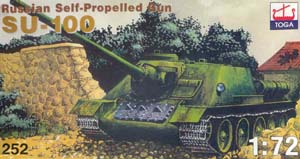
The box art for TOGA’s SU-100 kit is a touch crude but shows
the basic model in the box. Significant differences are that this
art shows the SU-100 with the correct angular fenders and solid dish-style
roadwheels; while the TOGA/AER kit actually contains steel-tired roadwheels
and the original T-34 curved front fenders which are incorrect for
an SU-100.
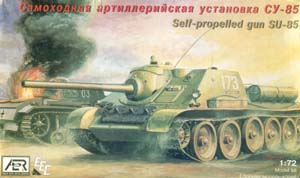
AER’s SU-85 box shows more accurately what is in their kit box
then the SU-100 kit. The front curved fenders are correct for an early
SU-85 and the roadwheels in the box are the same correct dish-style
actually within the kit. Unlike the ESCI T-34 dish roadwheels AER’s
does have the bolt detail. Note the subtle differences from the SU-100
in the mantlet and lack of commander’s cupola. The drum shaped
fuel tanks seen here were not typically used when in combat.
Compared to ESCI, these kits came in
the mid-1990s from the relatively new Belorussian and Russian manufacturers
to the US and to Western Europe. Besides these two Soviet WW2 assault
gun/tank destroyers a T-34/85 tank and a number of ZIS truck variants
were also offered under the Coopertiva, Toga, PST and AER company
names. Except for box art, instructions and decals, all these kits
under the different company names are the same.
The SU-85 was developed from the T-34/76
as a turretless, well armored self-propelled 85 mm gun, in order to
provide a more effective self-propelled antitank gun and for infantry
support like the German Sturmgeschütz and Jagdpanzer
IV. As the T-34/76 was up-gunned to the T-34/85, the SU-85 was in
turn up-gunned to the SU-100 with a 100 mm gun, in order to deal more
effectively with the German Panther and Tiger tanks. Entering service
in 1944, it continued on post-war with the Soviet Union and its European
allies, in Korea, and in the Middle East.
Each kit comes in about 118 injection
molded styrene parts of which 52 parts are the hard styrene link &
length tracks. I found surface detail to be respectable and the SU-100’s
size matches Esci's 1/72 scale T-34 well. [No, I did not measure it
out to check exact scale.] Getting the SU-100 first, I anticipated
that the SU-85 would be essentially the same kit though with a few
new parts, since they were very similar vehicles. In actuality the
two model kits are different entirely. While they both have similar
construction steps, the same tracks and approximate quality of surface
detail, it appears to me that the SU-100 is more 1/72 scale and the
SU-85 kit is slightly smaller in some dimensions. The SU-85 has the
dish-style T-34 roadwheels as well. The SU-100 kit has a mediocre
rendering of an all-steel roadwheel that was common to the T-34 of
1942 and 1943, not the SU-100 of 1944 and 1945.
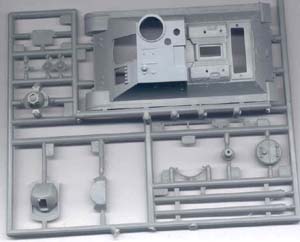
Here is a scan of the SU-100 sprue containing the superstructure,
mantlet parts and two 100-mm gun barrels at the lower right. The rear
superstructure hatch is separate though it's odd that the location
under the hatch location is solid, i.e. blanked off. The hull sides
can use some weld seams and the cupola can use vision ports. Overall
the hull is still quite respectable in detail and quality but not
up to contemporary Revell and DML quality.
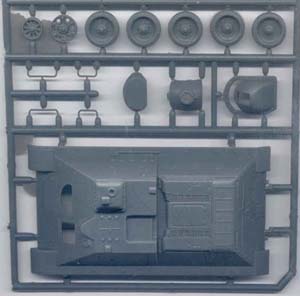
Comparing this SU-85 scan to the SU-100 kit scan above, we can see
that AER’s SU-85 superstructure is different from their SU-100.
The engine hatch is now modeled closed but the rear crew compartment
hatch is molded the same as on the SU-100. Note that there is no true
commander’s cupola on the SU-85 but a raised bulge with periscopes
(the later SU-85M based on the SU-100 hull did have the cupola). Fortunately,
the SU-85 kit has the correct roadwheel spacing.
Another odd error with the SU-100 (and
its companion T-34/85 kit) is that AER placed the larger roadwheel
gap between the vehicle’s third and fourth roadwheels when this
gap actually should be between the second and third roadwheels! I
did not catch this until after I built the kit. This error can be
fixed during construction by shaving off the third axle from the front,
and then repositioning it slightly back. This wheel spacing detail
on the SU-85 kit is correct. As this is not a full construction article
I refer to the many excellent references on the web and in our bookstores
for better clarification.

Left side of TOGA-AER’s SU-100. Driver’s hatch is open
with a rudimentary interior visible. Wire grab handles were added;
otherwise no aftermarket parts were used. The stout fuel tank on the
left side I understand to actually be for the smoke generator and
should be mounted on the rear plate outside of the exhaust (how much
we learn in nine years). Please do not use this old model as a representative
of an accurate SU-100.
I noted quite a problem with fit with
on my SU-100, particularly with the superstructure and lower hull.
It required much filling and sanding to close off the gaps. Like other
AER kits, the styrene seemed much softer than what I've encountered
with Revell and Hasegawa kits. Extra care then must be taken so as
not to sand off too much plastic or break parts. A plus is that the
tracks come in molded "link & length" styrene sections
like PST and the later Esci kits; except that the Russian kits have
well-formed track teeth which are missing from many ESCI styrene tracks.
The tracks went together well and were among the best in this scale
I've seen at the time I assembled my model about 10 years ago. The
engine and driver’s hatches I modeled open and a simple engine,
driver’s seat and gun breach built. There is no detail on the
inside of the SU-100’s driver’s hatch, though there is
detail on the inside of the SU-85’s driver’s hatch. Tow
cables were made from twisted copper strands. Etched brass frets for
the SU-100 are made by both Eduard (#22 019) and by PART (#P72021).
I have not noted any frets made for the SU-85 though many brass parts
for the SU-100 would be in common with both AFV’s. PART also
makes 1/72 etched brass T-34 tracks suitable for these kits.
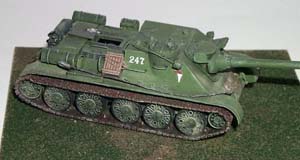
This is right side the 1/72 SU-100 with engine compartment open, a
scratchbuilt rudimentary engine installed, and with a wrench and rag
next to the open engine hatch. Note the incorrect spacing of AER’s
second and third roadwheels. The vehicle's tow cable was made with
twisted fine copper wire and the kit’s cable ends glued on.
The tires on the spider-roadwheels were a bit thick for all-steel
wheels, but too narrow for rubber tired wheels. Around the perimeter
of the wheels the holes should be drilled out. I believe that the
roadwheels are the weakest part of the kit and could use being replaced
by aftermarket wheels or wheels from another T-34 based model.
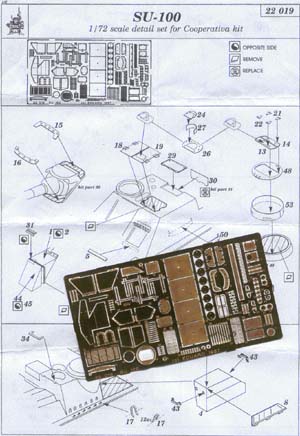
This Eduard etched brass fret #22 019 will certainly improve the detail
of AER’s SU-100 with new hatches, the correct angled front fenders
and a post-war storage bin that goes in front of the cupola. Replacement
cupola, fuel drums, fuel drum mounts and various fittings are also
included
Toga's kit instructions are adequate
and clear, though not as good as AER's. Painting guides are on the
box art and instruction sheet. When assembled back in 2000 I used
a medium Humbrol forest green enamel paint, though I usually prefer
Poly-Scale acrylics. No decals were offered in my kit, which is odd,
since markings and slogans were common on Soviet armor late in the
war. I borrowed some decals from AER’s Zis-5 truck kit.
Though the kit has some problems (and
what kit doesn't ?) an intermediate level builder should be able to
build this into a fine looking model. I recommend this kit for a beginner
to intermediate builder, especially for a wargamer where historical
accuracy is not as critical. I would refer a display modeler to an
UM or Dragon SU-100 or SU-85 models.
|